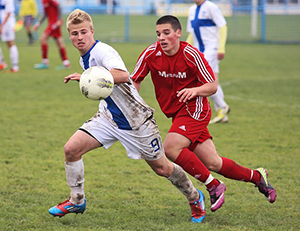Do You Play Soccer?
The injuries that I see in my office from playing soccer are very similar to those under the running injury section. Due to the constant running involved in soccer combined with the sudden sprinting that takes place it is important for proper muscle balance. Soccer injuries are usually lower body injuries and include calf strains, ankle sprains, hip pain, and plantar fasciitis.
Calf strains are treated with chirpractic adjustments to maintain proper lower body function. By adjusting the lower back, the pelvis, knee and ankle I ensure that muscles, especially the calf muscles are in balance. This promotes healing. Many times rest is recommended with strains but if you don’t fix the underlying structural imbalance that caused the strain then you are more likely to re-injure the area. Proper alignment prevents re-injury.
Ankle sprains can also be treated with chiropractic adjustments. There are many bones and different joints in the ankle and foot. When you “twist” your ankle, you are actually spraining the ligaments of the foot. A sprain occurs when a ligament has been stretched too far from being rolled or twisted. Adjusting the bones of the foot restores proper alignment so the sprain can heal quicker and stronger. If the position of the bones in the foot move when the ankle gets twisted, then proper healing cannot occur. This is why many people that sprain their ankle report many repeat injuries or weakness in their ankle after a sprain. They never healed properly because they never had the underlying structure fixed.
Plantar fasciitis is an inflammation of the bottom of the foot resulting in pain in the bottom of the foot. Usually this pain will get worse with activity to the point that it usually causes the athlete to stop competing for a period of time.
Plantar fasciitis usually occurs due to a weakness in the arch of the foot. When you lose the strength of the arch the foot “drops” more each time you put weight on the foot. When the foot “drops” more, it causes an increase stress to the plantar fascia which is a large tendon on the bottom of the foot which goes from the bottom of the heal and attaches to each of the bottom of the toes. The pain can be very severe. Adjustments to the foot help to restore the proper arch leading to increased strength in the foot. Proper arch support takes the stress off of the plantar fascia and allows it to heal. Other treatments for plantar fasciitis include taping, stretching, massage therapy, and proper running techniques.